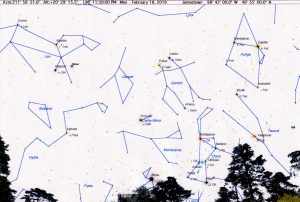
Jamestown (Tim Bratton) Dr. Timothy Bratton says, the IOTA (the organization that computes asteroid and lunar occultations) just factored in the revised path of Sirius, which is a double star system (the primary star is accompanied by a small white dwarf). The dwarf’s presence has yanked the epicenter (common center of gravity) of the Sirius system just enough that the occultation path will pass east of the United States altogether, so the U.S. wont see the tiny asteroid 4388 Jurgenstock cover the star, so there won’t be a “Disapearing Star tonight.” He adds,” Needless to say, I’m very disappointed about this!
Previously…
Jamestown (CSi) Dr. Timothy Bratton of Jamestown says if sky conditions cooperate, that around 11:30 p.m. CST on Monday evening, the “Dog Star” Sirius (Alpha Canis Majoris), the brightest star on our skies, may disappear for up to 1.8 seconds as the tiny asteroid 4388 Jurgenstock covers it. As luck would have it, the central path of this occultation (eclipse of the star by the planetoid’s tiny disk) runs almost directly through Jamestown! Your naked eyes, field glasses, or binoculars will be all you need to observe this event.
(The Voyager 4.5.1 (Carina Software) graphic shows the SSW-SW skyline at Jamestown at 11:30 p.m. on Feb. 18 (Monday), 2019. You can’t miss Sirius; it’s the brightest star in the sky, and lies to the lower left of Orion the Hunter. Sirius may disappear for nearly two seconds as asteroid Jurgenstock passes over it.)
At that time, dazzling white Sirius (magnitude -1.44) will be 20½ degrees above our SSW-SW skyline. Although Sirius is both larger and hotter than our own Sun, its brilliance is due mostly to the fact that it lies only 8.581 light-years from our solar system. Jurgenstock is only 2.9 miles wide, but is still close enough to us that its tiny disk might be able to blot out Sirius as it passes over the star. If Sirius is slightly wider than the current estimate of its diameter, or Jurgenstock is slightly smaller than anticipated, we might see a partial occultation; Sirius would dim noticeably, but not vanish entirely.
Because of uncertainties in Jurgenstock’s positions, we can’t predict the exact time when it will occult Sirius. To be on the safe side, look at Sirius for a few minutes on either side of the expected time of the occultation, 11:31 p.m. The star should wink out of sight abruptly for up to 1.8 seconds, although this duration might vary given the unknown shape of the asteroid. If you have a video camera mounted on a tripod that puts time stamps on each frame, you might be able to record this happening, which would be valuable for astronomers.
Jurgenstock, discovered on photographic plates in 1964, is a rather typical main belt asteroid, taking 3 years and 7 months to complete each circuit around the Sun between the orbits of Mars and Jupiter. At a magnitude of only 16.7, it is too dim to be seen in most amateur telescopes, and is more than 1.8 million times fainter than Sirius! The planetoid was named after the German astronomer Jürgen Stock (1923-2004), who determined that the mountain of Cerro Tololo in Chile was the ideal spot to install giant telescopes in South America. At the time of occultation, the planetoid will be 189,238,718 miles from the Sun and 123,377,059 miles from Earth.
















Comments are closed
Sorry, but you cannot leave a comment for this post.